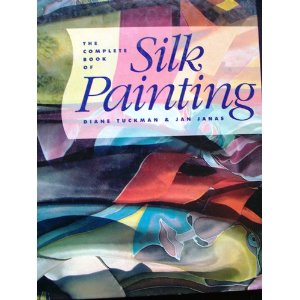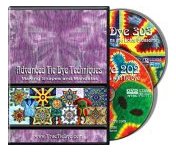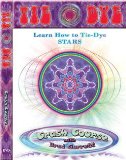Main | 2014 January »
Friday, February 14, 2014



Silk Painting: The Artist's Guide to Gutta and Wax Resist Techniques
by Susan Moyer




The Complete Book of Silk Painting
by Diane Tuckman




Beginner's Guide to Silk Painting
by Mandy Southan


Learn silkpainting
from a master


DVD: Silk Painting
With Jill Kennedy





(Please help support this web site. Thank you.)
Thursday, February 13, 2014
What is the science behind the effect of salt when rinsing garments with loose dye?


Country or region: Australia
Message: Hi, I have noticed when rinsing garments that have loose dye in a saline solution that the dye stops bleeding dramatically. I was just wondering what the science is behind this. Is the salt forcing the dye back into the garment? If the garment was then dried, would the dye be less likely to rub off temporarily? Of course next time the garment is washed with detergent the dye starts to flow again. I realise that salt doesn't set dye but was wondering also if this inhibiting effect is the reason behind the old wives tale. Thanks.
P.S. & thankyou for your wonderfully informative site.
I am sure that you are correct about this being the source of the claims that salt will set dye. It's unfortunate that the effect is so temporary.
Wednesday, February 12, 2014



Advanced Tie Dye Techniques: Making Shapes and Mandalas
by True Tie Dye




Tie Dye Crash Course - Stars
by Phat Dyes




How to Tie-dye Stars: Book 2 of the Tie-Dye Art Series
by Richard W. Rogers


Country or region: Panama
Message: Hello! Thanks for your time and sharing your experience. I have some questions: Which is the relation between fabric weight and quantity of dyes, I am tie dyeing sheets, and the best way to do it? Also, have some of them with the soda bath all ready on, to save time, they are dry now, when I want to dye them, do I have to wet them? In which substance? only water? or soda water? thanks!!
I was wondering if you could help me out. I normally dye silks and have
used various brands. But recently I've been trying to get my hands on
some dark turquoise. The make I bought before is no longer available.
-ADVERTISEMENTS-

Silk Painting: The Artist's Guide to Gutta and Wax Resist Techniques
by Susan Moyer

The Complete Book of Silk Painting
by Diane Tuckman

Beginner's Guide to Silk Painting
by Mandy Southan
Learn silkpainting
from a master

DVD: Silk Painting
With Jill Kennedy
I've had no luck trying to mix one for myself as it always end up
looking like teal. What would you suggest to get a good colour? I have
many Dupont acid dyes but none of them are anywhere near what I am
looking for.
What dye did you use before that is no longer available? In some cases I
can identify a specify dye chemical, which would help in suggesting an
alternative.
The dye in question was dark turquoise, an acid silk dye made by Marabu.
Unfortunately it is impossible to identify any of the pigments used in Marabu silk paints, so I can't use that to help find the same dye under another brand name. In fact, it looks like the Marabu Silk Colours are not true dyes at all, but instead paints, in which insoluble pigments are combined with a binder to make the pigments adhere to the fiber. Dye-based silk colors are set by moist heat, such as by steaming, while pigment-based silk colors are set with dry heat, such as by ironing; as a result, dyes and paints cannot be used at the same time. The first of these two different types of color (dye or paint) you use must be fixed in place and any excess rinsed out before you use the other type of color (paint or dye) on the same piece.
However, at least the name can be used to find a color chip to compare to. These are from an online color chart for the Marabu silk paints:

Key question: Is the unwanted color you've been mixing too dark, or too bright, too dull, too green, or too blue?
I can't tell which of these the problem is, from your description so far. The color of the "dark turquoise" chip on the Marabu Silk Paints online color chart looks very much like teal to me; in fact, it is identified as "teal" if you plug it into a color naming tool such as Chirag Mehta's "Name That Color" at http://chir.ag/projects/name-that-color/#008181 . (This is a fun online color tool to play with.)
If the color you're mixing is too dark, you might get the color you want simply by using less dye, or by adding more dye dilutant, while otherwise mixing it just the same as you have been doing. If your color is too blue, try adding a drop of yellow dye; if it is too green, try adding a drop of blue dye. If the color is too dull, then you need to find a clearer blue and green to use in your color mixing, with a blue that is more turquoise and less royal blue to begin with, or a yellow that is less orangish.
When using Dupont Silk Dyes, which are mixtures of various types of unidentified dyes, to make the dye more blue, the mixing blue primary colors are supposed to be 265 ('Bleu Roy') and 205 ('Limoges'), though as a rule medium blue colors are not as good for mixing bright greens as more turquoise hues will be. To make it more green, use a little yellow; the mixing primary yellow colors are supposed to be 717 ('Jaune Primaire') or 715 ('Jaune de Chrome'). 'Jaune de Chrome' is more golden (orangish) than 'Jaune Primaire', so it will make a somewhat more olive hue when used to mix greens.
Not everyone likes to use Dupont dyes for mixing their own colors; many people use only the colors as as already available, since there is such a huge range of different colors that are sold. If you want to try another line of steam-set silk dyes that is similar to the Dupont line, you might consider that the Sennelier Tinfix line of dyes includes a color, 'Celadon', whose color chip looks, as far as I can tell, rather close to the color you are trying to find, just a little brighter and a tiny bit greener. The following is the color that is shown online by Dharma Trading Company for the Sennlier TinFix 'Celadon':
Compare the Tinfix Celadon color on the "Name That Color" page mentioned above with the link http://chir.ag/projects/name-that-color/#01887A .
Pebeo Setasilk, another line of iron-fixed silk paints, has a 'Turquoise' which is a lighter and brighter color than Marabu's 'Dark Turquoise' (color taken from the online color chip at George Weil):
Are you only going to be painting silk designs, or are you looking for a silk dye that can also be used for coloring a larger piece? If the latter, have you tried PRO Chemical & Dye's Washfast Acid Dyes? The color chip shown for PRO Wash Fast Acid 'Turquoise' 478 looks very close to the Marabu Silk Paints 'Dark Turquoise' color chip. This dye is also known by the generic name Colour Index Acid Blue 7:

Of course any specific dye color I mention may really turn out to be less satisfactory than the mixes you have already been making. We must be careful about concluding very much from a color chip; since different computer monitors are calibrated differently, a color chip that looks like the right color on one monitor will look like a different color altogether on another monitor, so we are never sure whether what we are seeing online is what a manufacturer expects us to see. This is why printed color charts are more reliable than those you can see online; a company will send out printed color sheets only after checking that they have been printed correctly; they can't check for whether our monitors show us the same color as theirs are showing them. Even if the color chip we are looking at is correct, the brightness of the fabric that we dye, or the exact methods and concentrations we use, can alter the ultimate color considerably. That said, color chips are still handy to look at while thinking about dye colors.
To play with mixing colors before you get out your real dyes or paints, I strongly recommend trying Olli Niemitalo's Dye Mixer Applet, at http://yehar.com/blog/?p=307 ; even if you don't find the dyes or paints you are using in its listing, you can still use it to clarify in your mind what happens when you add another color, by mixing similar colors from the list choices it includes.
(Please help support this web site. Thank you.)
Thursday, February 13, 2014
What is the science behind the effect of salt when rinsing garments with loose dye?
Name: Mike
—ADVERTISEMENTS—
Unlike salt, iDye Fixative and Retayne do stop dye bleeding in purchased clothing.
Country or region: Australia
Message: Hi, I have noticed when rinsing garments that have loose dye in a saline solution that the dye stops bleeding dramatically. I was just wondering what the science is behind this. Is the salt forcing the dye back into the garment? If the garment was then dried, would the dye be less likely to rub off temporarily? Of course next time the garment is washed with detergent the dye starts to flow again. I realise that salt doesn't set dye but was wondering also if this inhibiting effect is the reason behind the old wives tale. Thanks.
P.S. & thankyou for your wonderfully informative site.
Salt reduces the solubility of dyes in water, so adding salt turns water into a less effective cleaner. When the same item is again placed in clean water, the unattached dyes can once more bleed easily into the water.
(Salt is also useful for reducing the amount of dye needed to be used in high-water-ratio immersion dyeing, but in that case it's not doing anything to set the dye, it is just making it easier for the negatively-charged dye molecules to find the negatively-charged fiber molecules.)
Rinsing in salt water does not reduce the incidence of crocking (which is what it's called when dry particles of unattached dye rub off onto other items, often ruining them). The only way to reduce crocking is to remove the excess unattached dye--or, depending on how bad the situation is, to start over with a new piece and apply the dye more correctly.
Two other factors that temporarily affect how well unattached dye washes out are the temperature of the washing water, and how hard the water is.
Hotter water is far more efficient than cooler water at washing out unattached dye; this is why we wash out the excess from good permanent reactive dyes with the hottest water available, as it saves water overall and works better, but we wash woolens that have been dyed with more weakly-attached dyes only in cool water, to make the color last as long as possible.
Hard water is water that contains mineral ions, such as calcium or magnesium. Garments that have been dyed and then washed in hard water can appear to have had all of their excess dye removed, and yet then bleed dye once more when washed in softer water. It is best to wash out excess dye with water that is not hard, or water that has been softened by replacing the calcium ions with a little sodium, or water to which a water softener such as sodium hexametaphosphate has been added. Many dyers always add a small amount of the water softener sodium hexametaphosphate to their dyebaths and to their washing-out water.
One of the ways to exploit the reduced solubility of dyes in salted water is an answer to the problem of after-setting Procion dyes. It is possible to use soda ash to set the dye by adding it to the fabric in one of three ways: before the dye, with the dye, or after the dye. For tie-dyeing or dye painting, it is best to either presoak the fabric in soda ash, or to mix the soda ash directly with the dye mixture and use it quickly. The third method, after-fixing by first painting the dye onto the fabric, and then soaking it in dissolved soda ash, will tend to destroy any detailed design, as the dye on the fabric will dissolve in the soda ash mixture and transfer to parts of the fabric where it is not wanted. However, sometimes people forget to use the soda ash until after they have already painted on their dye. To salvage the unfixed design, you can fix it by painting on a water glass solution (this is sodium silicate dissolved in water), or you can add as much salt as can possibly be dissolved to the soda ash, so that most of the dye will stay in place. It's not perfect, but it is much better for preserving the design than after-soaking in just plain soda ash without the salt. (The recipe is 359 or more grams of salt [which is 166 ml, or about 2/3 of a US cup]—use a little too much salt, to be sure that you have as much as can be dissolved—plus a quarter cup of soda ash (60 ml), per liter of water.)
(Please help support this web site. Thank you.)
(Please help support this web site. Thank you.)
Wednesday, February 12, 2014
Name: Mar
—ADVERTISEMENTS—

Advanced Tie Dye Techniques: Making Shapes and Mandalas
by True Tie Dye

Tie Dye Crash Course - Stars
by Phat Dyes

How to Tie-dye Stars: Book 2 of the Tie-Dye Art Series
by Richard W. Rogers
Country or region: Panama
Message: Hello! Thanks for your time and sharing your experience. I have some questions: Which is the relation between fabric weight and quantity of dyes, I am tie dyeing sheets, and the best way to do it? Also, have some of them with the soda bath all ready on, to save time, they are dry now, when I want to dye them, do I have to wet them? In which substance? only water? or soda water? thanks!!
Use the same weight of dye per weight of fabric, in order to reach a particular color. If you use more fabric for the same amount of dye, by weight, you will get a lighter color overall. You should weigh your sheets, while they are dry, and then multiply the amount of dye, water, and soda ash you use by the same number, so that the dye will be the same concentration and the same color as when you are tie-dyeing smaller projects.
The best method for tie-dyeing sheets begins with using the right dye. Using an all-purpose dye or a direct dye will not work well for tie-dyeing, because these types of dye bleed from one part of the design to another. To create tie-dyed sheets in multiple colors, you should use a fiber reactive dye, such as Procion dye or Remazol dye. Soda ash (sodium carbonate) is the chemical that will set the fiber reactive dye; it will not help with all-purpose dye or direct dye.
You must use sheets that are made of natural fibers, not polyester. Cotton, linen, and rayon are all good. Sheets that have been treated to prevent wrinkling will not dye as brightly or evenly as untreated sheets.
To predict how much dye you need to use, see my page, "How much Procion MX dye should I use?". To tie-dye sheets that weigh three pounds (or 1.4 kilograms), you will need about 30 grams of Procion dye powder; you will need less if you are leaving a lot of white in your design, or more if you will not be leaving any white. Dissolve one-half to one cup (125 to 250 ml) of soda ash in each gallon (4 liters) of water, to soak your sheets in, just as when tie-dyeing clothing.
Pre-soaking the sheets in soda ash and then letting it dry is an excellent approach. The soda ash will stay in the fabric even after it has dried. There is no need to wet the sheets before dyeing them, if they have the soda ash dried into them. The dry soda ash will combine with the wet dye mixtures to enable the dye to react with the fiber.
You can soak the sheets in soda ash and then hang them up to dry, then tie them and apply the dye. Alternatively, you can tie the sheets while they are dry, or dampened with plain water, then soak the tied sheets in soda ash, then squeeze out extra moisture and allow the sheets to dry while they are tied. Of course it will take much longer to let the sheets dry if they are tied. You can apply the dye to sheets that are quite wet with soda ash mixture, or partially dried, or completely dry.
Some dyers prefer to work with dry fabric that has soda ash in it, while others prefer to work with wet fabric. If you do choose to rewet the sheets before dyeing, spray them lightly with only a small amount of water, so that you do not wash away any of the soda ash.
Fabric that has been soaked in soda ash solution and allowed to dry will have dry soda ash powder throughout the fabric. Be careful when handling these sheets. Soda ash has a high pH and is irritating to the skin, to your eyes, and to your breathing. Wear a face mask to keep the dry soda ash dust out of your nose and lungs, and wear thin plastic gloves to protect your hands from becoming red and dry. If you work with the sheets while they are still wet, you don't have to worry about breathing the soda ash; only the dry soda ash flies into the air where you can breathe it.
(Please help support this web site. Thank you.)
(Please help support this web site. Thank you.)
